Content
- Kit Selection for Saltwater Fly Fishing
- Where to fly fish for Bass
- When to Go Bass Fishing
- Sea bass fishing techniques and flies
- Orvis Saltwater Fly Fishing Festival
I started fly fishing for sea bass during a summer holiday in Cornwall a few years ago. It was such a great experience that subsequently, I have spent the summers fly fishing for bass in North Wales.
I’m still on a learning curve, but I decided to share the useful pointers I’ve picked up along the way, which will be helpful to a beginner.
So, let’s start with an overview of the fly fishing equipment you will need…
1. Kit Selection – fly fishing for sea bass
As with most forms of fly fishing, you can spend a fortune on the fishing tackle for saltwater fly fishing.
However, I would recommend an inexpensive start to fly fishing for bass, and this is the course I’m going to outline. Then, if you get hooked on it, you’ll be able to upgrade to a specialist saltwater fly fishing rod and reel.
Saltwater fly rods for sea bass fishing
The essential feature of a fly rod for sea bass fishing is its capability to cast a relatively large fly against an onshore breeze.
If you already fly fish on freshwater lakes and large reservoirs for trout and/or pike, then you probably have a rod you could repurpose to have a go at saltwater fly fishing for bass.
Important note – if the rod is not designed for saltwater fishing, it will need to be thoroughly washed off in clean water after every trip. As the salt environment can wreck many a reel if it’s not saltwater corrosion-proofed, likewise with Rods.
A robust 9-10ft reservoir fly rod rated 8 or 9 wt is an ideal choice. However, a 7wt rod will work for fishing on calm days with smaller flies.
If you’re moving straight to saltwater fly fishing, there are a couple of options to consider:
- Pick up an inexpensive second-hand 8 or 9wt freshwater fly rod, or…
- Buy a new saltwater fly rod. They are available to suit a range of budgets. For example, an entry-level Airflo Predator/Saltwater Starter Kit – 9′ – 8/9 that includes a reel and line for under £100.
I’m currently using a 20-year-old Snowbee Deep Blue XS 9ft 8wt fly rod, which satisfies my current sea bass fly fishing requirements.
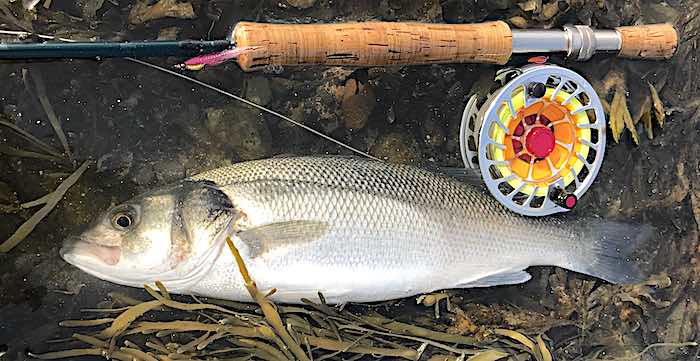
Saltwater fly fishing reels
As with fly rods, you can spend up to a small fortune on a high-specification saltwater fly reel.
However, there’s no need for an expensive drag system when fishing for sea bass from the shore because large amounts of backing are not required to subdue them, unlike monster tropical fish.
I started my saltwater fly fishing journey using a cheap, second-hand Shakespeare Oracle Salmon Fly Reel (8/9), which served me well for a couple of years. Important note – if the reel is not designed for saltwater fishing, it will need to be thoroughly washed off in clean water after every trip.
Now, I’ve upgraded to an Airflo V2 reel, which was designed for saltwater environments and incorporates a sealed drag system.
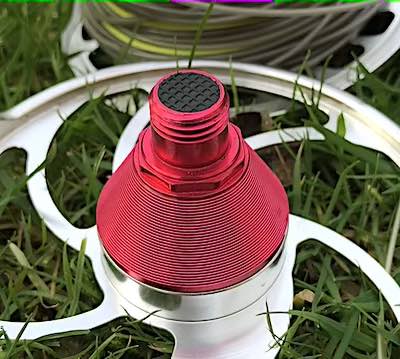
Fly lines for sea bass fishing
For fly fishing in UK seas, you will need a coldwater fly line and not a tropical (warm water) fly line because they stiffen in UK waters.
I started fly fishing for bass using a standard weighted forward freshwater line matched to the rod rating, which was OK for small, lightweight flies.
However, I now use a 9wt Rio InTouch Pike/Musky line (floating and intermediate) with the 8wt rod because its short front taper (shooting head profile) turns over bigger flies in a stiff sea breeze.
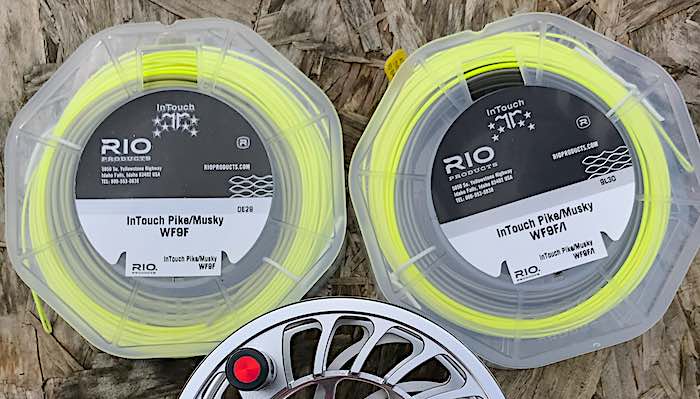
Fly fishing for sea bass from the shore is easily covered using floating and intermediate lines, but you’ll need to add a fast-sinking line for fishing deep water marks. For example, the Airflo Forty Plus DI5 or DI7 fly Lines or the Airflo PolyfuseXT Depthfinder sinking fly line, depending on your budget.
Loading the line on top of approx.100 meters of backing will be more than enough to subdue even large sea bass.
If you get hooked on saltwater fly fishing and plan to fish regularly for sea bass, it will be worthwhile buying tackle designed for saltwater and capable of casting large, bulky and sometimes heavy flies into a strong wind.
Until then, it will be necessary to diligently wash your rod and reels with fresh water to remove any saltwater and sand; otherwise, they won’t last long.
Fluorocarbon leaders for sea bass fishing
Leaders, the connection between your fly line and fly is the area of the saltwater fishing tackle that is worth using a good abrasion-resistant fluorocarbon.
Leaders, the connection between your fly line and fly is worth the expense of a good abrasion-resistant fluorocarbon for saltwater fishing.
I use 9ft Seaguar Saltwater IGFA Leaders rated at either 20 or 16lbs breaking strain and tie on a 2ft of 15.4lbs Seaguar Ace Hard fluorocarbon tippet via a loop-to-loop connection. The tippet section is replaced each trip if not before. There are cheaper options, but I’m happy with the additional expense.
Accessories for fly fishing for sea bass
Polarising Sunglasses
It’s always wise to wear sunglasses because they offer eye protection from the sun and flies. When fishing for sea bass at night or in low light conditions, replace the sunglasses with safety glasses.
Chest waders & boots.
When fishing from the shore, you’ll often have to wade out to reach the best fishing spots. This is where a good pair of socking foot chest waders and wading boots will provide warmth and comfort, thus allowing you to concentrate on the fishing.
Having said that…
In the height of summer, it can be refreshing to wet-wade in shorts and an old pair of trainers.
Wading Stick/staff
I never go wading without one, it’s my third leg…
Because it helps me safely get to the good fishing locations by navigating slippery rocks and boulders, checking the depth of rock pools and the firmness of the ground, and wading through murky water.
Line tray / Stripping basket
Saltwater fly fishing without a line tray can be a real pain. An inexpensive line tray stops your line from tangling in the surf, line damage on sharp rocks, and weed tangles in shallow water. Thus, allowing you to focus on fishing.
Landing Net
Most of my fishing for sea bass is from the shore and rock marks. Therefore, I use a landing net that fastens to my back and has an extendable handle. This keeps the net out of the water when wading, and the extendable handle is useful when netting bass from rocks.
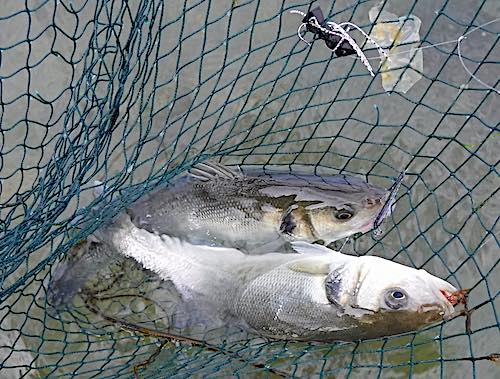
Small Backpack / Chest pack
A small waterproof backpack or chest pack is useful for carrying essential fishing items, e.g. flies, leaders, lines, snacks, drinks, etc. Enabling you to easily move along the shoreline and in and out with the tide.
Fishing Headlamp
If you are planning on bass fishing early in the morning or into the night, then it’s worth investing in a good headlamp. I use the Nitecore NU25 headlamp because it’s lightweight and easily fits into my jacket pocket.
2. Where to fly fish for sea bass
Well, you have a large coastline in the UK to fish. According to the Ordnance Survey…
“The coastline length around mainland Great Britain is ca. 11,000 miles”
This is both good and daunting.
So, how do we go about narrowing that down because…
Location and timing are important sea bass fishing success factors.
- Select an area of coastline within a comfortable driving distance of where you are staying, which could be home or a holiday destination.
- Search online for known sea bass fishing marks within that area. For example, the Fishing in Wales website has an interactive map that shows some of the key fishing marks with information on the species to target.
- Ask for advice on saltwater fly fishing forums. Someone might point you in the right direction.
- Reach out to local fishing tackle shops, as they may have useful knowledge on where to start fly fishing for bass.
- Once you’ve found a good location to fish, it’s time to identify the places where bass are likely to be feeding at a distance you can cover with the fly (ca. 20 meters or closer to your rod tip).
- Fortunately, bass will feed close to inshore structures because they hold their food source, e.g. baitfish, shrimps, crabs, etc.
- Shoreline structural features include boulder-strewn, rough ground, rock gullies, large rock pools, deep inshore drop-offs, kelp beds, sand bars, rips, etc.
- Many of the features are found in estuaries and, as such, hold a good head of small sea bass. Thus…
Estuaries are a great place to start fly fishing for sea bass
The next step involves legwork…
Your chances improve with the more shoreline you cover, which contains any of the above features that schools of bass love to inhabit. So…
Pick an area and start exploring it with your fly rod. Keep an eye out for…
- Fish swirling at the surface,
- Bait fish jumping out of the sea.
- Diving sea birds feeding on bait fish schools.
Because they’re all signs that sea bass will be close by.
Bear in mind…
Effort equals reward in the Bass fly fishing game!
Therefore, it pays to travel light to make it easy to cover as much water as possible.
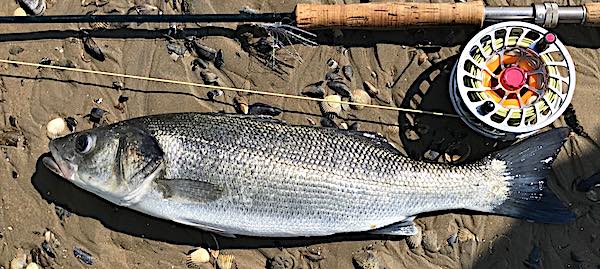
3. When to go fly fishing for sea bass
In North Wales, I usually start fly fishing for bass in May and stop in October when it gets cold, because my focus switched to Autumn grayling fishing. On the warmer south coast, the fishing season is extended by a couple of months.
Sea bass fishing typically peaks in July and August. Therefore, as a beginner, it is the best time to learn your craft because there are more fish around. Thus, your chances of locating and catching are higher.
Time of day / light levels
In bright sunshine, bass can be caught from the shore when fishing deep water during the day. However, when fishing shallow water, your chances significantly improve at dawn and in the evening. Thus, pays to have a…
Very early start or late finish.
This is often accompanied by the bonus of a magical sunrise or sunset.
On dull overcast days, sea bass become confident enough to move inshore and venture into shallow water to feed.
Fly fishing in these low-light conditions becomes productive, especially during the dark. However, from a safety point of view, fly fishing from the shore in the dark is fraught with hazards and best avoided if you’re a beginner or by yourself.
Tide times
It’s important to study the tide table for where you plan to fish to understand the times for high and low water. So, you know when to move out and in with the tide. It’s safer to fish an outgoing tide because you don’t have the hazard of getting cut off by a rising tide.
In each lunar cycle (28-day period), there are two sets of spring tides (large difference between high and low water) and two sets of neap tides (small difference between high & low water).
Generally, I prefer to fish when the tides are getting larger, but that doesn’t stop me from fishing a falling tide when low water is at sunrise or sunset.
Each location will fish best during a portion of the tidal cycle, depending on the feeding behaviour of bass in that area. For example, the best time is often a couple of hours on either side of low water for estuaries, low water rock marks, and kelp beds
If you can’t find any information for the area, you will have to fish it several times to determine the best phase of the tide.
Weather conditions
I prefer to go sea bass fly fishing on overcast, breezy days and when the sea is clearing after a mild storm because bass are likely to be feeding inshore on dislodged crabs and baitfish.
In flat, calm seas, I prefer to go sea bass fly fishing at daybreak and in the evening.
Water Clarity
I’ve had most success fly fishing for bass when the water visibility is at least 3ft. If the visibility is less, it’s possible to catch bass on the fly using large colourful or black flies, but I try and find deeper water over rocky outcrops, which tends to be clearer.
4. Sea bass fishing techniques and flies
Fishing over shallow water (ca.<10ft)
I normally start with a floating line tipped with a 9ft Seaguar Saltwater IGFA Leader (16lbs breaking strain) and tie on 2ft of 15.4lbs fluorocarbon when fishing for sea bass over shallow water. This simple leader setup is the one I would recommend when starting your journey.
Sea bass can be feeding very close in. Therefore, it’s important to cast out a fan shape to cover the water in front of you before wading out. Experiment with slow and fast retrieves as you move along the shore.
If you get your fly in front of feeding bass, they will normally have a go at it. The challenge is finding the fish in the first place. So, keep an eye out for…
Fish swirling at the surface, baitfish jumping out of the sea, diving sea birds feeding on baitfish schools.
It’s important to learn how to double-haul cast and punch flies out on windy days because you will cover more water and catch more sea bass.
If you don’t get any takes when covering feeding bass, it’s time to experiment with fly choice…
Sea bass fly choice
Fly choice depends on what bass are feeding on, i.e. baitfish, sand eels, crabs, prawns, or shrimps. Fortunately, they are opportunistic feeders and will often take any fly that imitates their typical food sources.
The saltwater flies that I’ve found successful for sea bass fishing include…
Sand eel fly patterns
I’ve had the most success fishing simple bootlace sand eel fly patterns (ca 3″ long and hook size 4 to 1) from the shore over kelp beds in North Wales. Personally, I haven’t had any luck with the larger sand eel fly patterns.
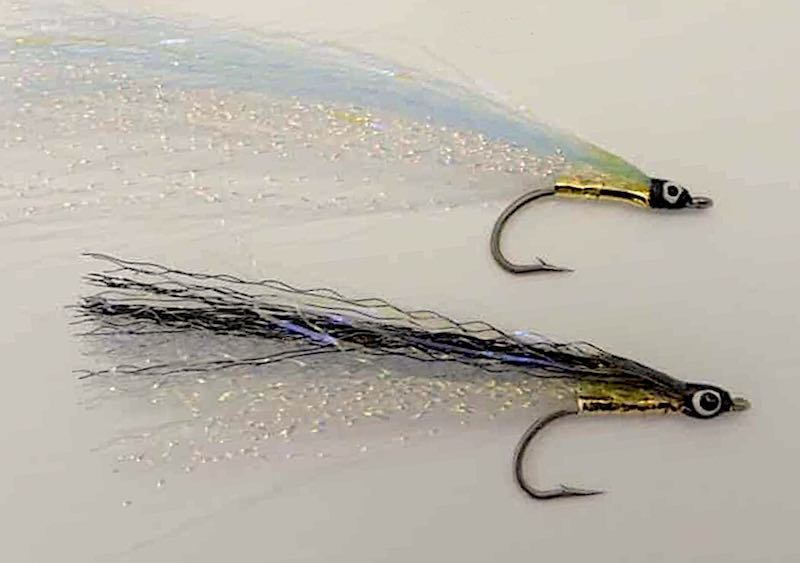
Crazy Charlie flies
I carry a range of Crazy Charlie saltwater flies in different colours and weights to tempt bass feeding on shrimps, prawns and fry.
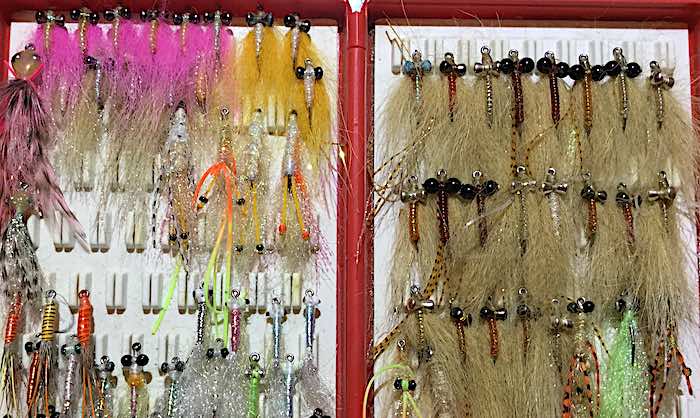
Baitfish Patterns
It’s worth having a selection of baitfish flies tied in various colours and on size 2 to 2/0 hooks because they are often highly effective when sea bass are feasting on small fish.
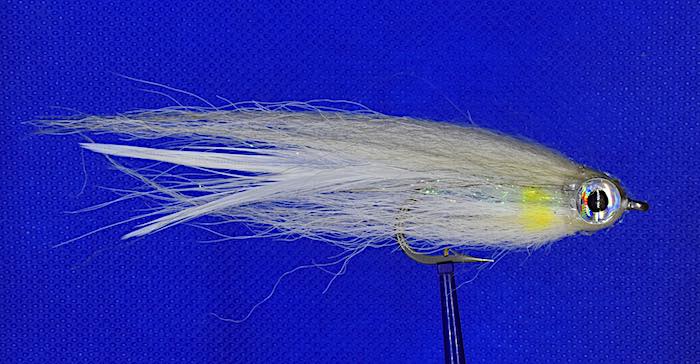
Sea bass surface lures/flies
Surface flies are the final class of flies I carry when out fly fishing for sea bass.
I fish the foam body patterns because they are easy to cast. They are sometimes referred to as “NASTIES”.
When pulled across the surface sea bass find them irresistible when they are feeding on fry.
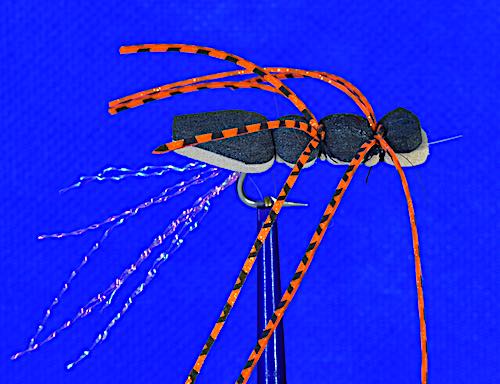
Surface flies can be fished on their own, but fishing them on a dropper 5ft above a subsurface fly works a treat. Often, bass will investigate the disturbance but take the subsurface point fly.
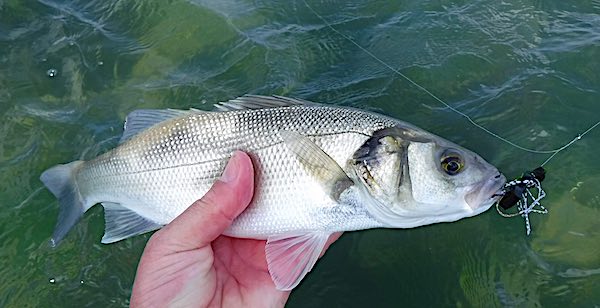
Fishing over deep water from rock marks
Even over deep water, it’s worth starting with the floating line set-up because bass could be feeding near the surface. However, the best results are likely to come from fishing an intermediate line or a fast-sinking line, especially on bright days.
I use a simple leader setup consisting of 6 to 8ft of fluorocarbon (20 lbs breaking strain) when fishing with intermediate and sinking fly lines.
Fly choice is similar to that for a floating line set-up, except for the surface flies.
It pays to use a systematic approach when fishing with sinking lines…
- Initially, I will cast out, count 5 seconds before starting the retrieve.
- Repeat the cast and count down until the area in front of you has fanned.
- The above steps are repeated with a 10-second count, then 15 seconds, etc. Until you’ve covered the water column.
- Don’t forget to vary the speed of retrieval as well.
- Then move on and repeat the process further down the shore.
Once you start to get takes, you can focus on fishing at that depth (countdown rate) until you stop getting takes.
5. Orvis Saltwater Fly Fishing Festival
For a few years, Orvis has organised a saltwater fly fishing festival that offers the opportunity to learn from several saltwater fly fishing experts. This year, it is taking place from 27th June to 29th June 2025 in Chichester Harbour and Hayling Island.
Finally, I hope this article stimulates you to try fly fishing for sea bass during the summer and that it helps you catch your first fish.
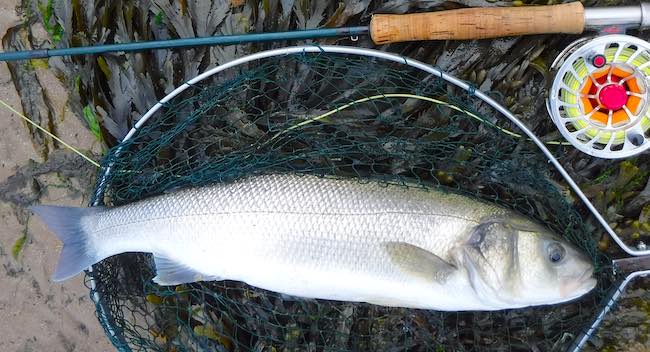
Excellent Andrew, I’ve had a play about with the fly gear in Dorset a couple of weeks back. Had absolutely no idea what to use or how to use it. But as always your blog makes a lot of sense. Keep them coming please.
Hi Patrick,
It’s great to hear that you have found the article very helpful and I hope you caught a few sea bass soon.
Thanks for the feedback. Cheers Andrew
Hi Andrew, I do a lot of Bass fishing with the fly. Great article. Hope to meet you. on a beach one day…
Hi Garry,
Thanks for the feedback on the article.
Cheers, Andrew
Good read that, i do wish that people would stop calling them sea bass tho, they are Bass, it is arty farty chef’s that started calling them sea bass.
Well said it’s one of my real bug bears!!!
No such thing as a sea bass
They are seabass as they live in the sea! Really don’t see what the problem is and not sure it was chefs that first started calling them that. Many bass species are freshwater. Think of the bass in America which have also been introduced into parts of Europe. So hop over to Spain and they have SEAbass and freshwater bass. They are much worse things to get irritated by!
We are in the UK we do not have fresh water Bass The Bass we catch are Bass or but for those who speaks latin it is Dicentrarchus labrax .
No such species as Sea Bass, I too get very agitated by knobheads who brought in the term purely for profit and cullinary fame on TV, Bass are Bass. And where I live, we fish for them in rivers, not called River Bass!!
Great article Andrew
Some of those Charlie’s look familiar
Well spotted 🙂
Great blog, are sea bass common on the West coast of Scotland?
Hi Stuart,
I’ve never fished for bass in Scotland. Attached is an article https://www.fishmag.co.uk/scotland/ that mentions the west coast is a good place for bass fishing.
Hope this helps, Andrew
PLEASE…It is a BASSS no more no less.Look it up.You can call them what you want if you are a Poncy Chef but if yoy are a True Angle it is a BASS!!!!!!
Fly fishing for sea bass? Those are not sea bass. Sure it’s of the bass family, but just Google what a sea bass is. They are black and have nice colors like aqua, blur, and white.
Hello – very useful summary of kit etc for Uk fly fishing for bass. Thanks
Cheers
Hi Andrew , you mention the airflow v2 because of the sealed drag, it seems very difficult to find online, do you have any other suggestions for sealed drag reels, because I don’t want a reel that will corrode easily because that is a real buzz kill.
Will
Hi Will,
It looks like they have upgraded to the V2 to a V3 reel, which still has a sealed drag https://www.fishingmegastore.com/fly-reels/airflo-v3-large-arbour-fly-reel~69979.html
I hope this helps,
Andrew
Hi Andrew
Very interesting Sea Bass article, they are pretty much all round our Coast and are a real alternative to salmon and seatrout. Off the Fylde coast the water is often sandy-muddy but the bass still home in on the fly in these conditions.
Understanding tides is important but perseverance reaps rewards
Hi Philip,
Pleased to hear you enjoyed the post and thank for the comment.
Tight lines, Andrew
Andrew,
Very much appreciate the post. Very informative.
I just been lucky enough to move to Biarritz France for a year. The French in their infinite wisdom close all rivers to fishing after sept. so I thought I’d try fishing the sea, which I have VERY little experience in, besides what I’ve done in my home country of Canada. Got my 8wt. Any idea if fishing these waters would yield anything in the winter and any particular suggestions?
All the best
Ian
H Ian,
My saltwater fly fishing has so far been limited to fishing in the UK. So, unfortunately, I can’t help with fishing the coastal waters of France but I’m sure you will be able to catch bass there.
Tight lines, Andrew
Great review! The write-up is excellent and incredibly informative. I’m gearing up to try seabass fishing this summer during my holiday, and your guide has been a game-changer. The tips, tactics, and insights into leader, tippet, and rod setup have boosted my confidence to dive into the experience. Many thanks for the excellent guidance!
Hi Ricky,
Great to hear you have found it useful. If you have any success over the summer let me know.
Tight lines, Andrew
Hi Folks,
I’m a complete beginner to fly fishing. I have recently purchased a new #9wt rod for Bass fishing.
When it comes to Leader and Tippet, for me it seems to be so vast when choosing the correct lines.
I have Airflow WF-9 floating line. From your experience can you recommend the appropriate leader and tippet that I should match this to and also a link to a supplier where I can purchase recommended lines. Thanks, much appreciated.
The simplest way to get started is to add a 5ft Airflo salmon floating polyleader https://www.fishingmegastore.com/tapered-leaders-and-casts/airflo-polyleader-salmon-and-steelhead-5ft~1130.html to your fly line. Then tie on 4 to 5 ft of 15 lbs fluorocarbon tippet. I use Seaguar Ace Hard https://www.fishingmegastore.com/tippet-material/seaguar-ace-hard-fluorocarbon~1904.html.
I hope this helps, Andrew
Hi Andrew,
Thank you kindly for your reply. I’ll order those lines in. Much appreciated, just didn’t want to be buying incorrect items. So many different views on the subject online, so for me it was getting confusing.
TY
No problem. It would be great to know how you get on fly fishing for bass.
Tight lines, Andrew
Love your blog,now subscribed. Do you have any recipes for the flesh you’ve mentioned
Hi Neville,
I do and I will put together a short post on them.
Tight lines, Andrew